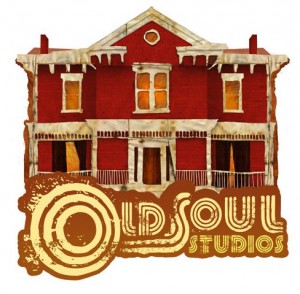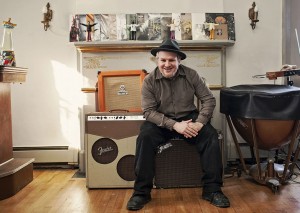Destination Studio: Old Soul Studios, Catskill, NY
Back in 1995, Kenny Siegal was living in New York City, working out of a personal studio in DUMBO, long before that neighborhood had turned into the chichi business district it is today.
His studio at the time was a subterranean lair, deep in the basement of 68 Jay Street, part of a space that would eventually be revitalized and become part of the now ever-expanding Saltlands Studios. But then it was just one room in a vast and empty cellar. That is, until the metal heads moved in and started rehearsing next door. That made recording a challenge, to say the least.
“I knew there had to be a better way to do this,” says Siegal, the producer and songwriter who would come to own Old Soul Studios and a record label by the same name. “That’s when I started looking outside of the city, to finally try and find a better environment to work in.”
By 2001, Siegal had bought a historic greek revival home in the Catskills, about 100 miles outside of the city, where he built a home studio. That studio grew and grew until at times, it seemed poised to take over the whole house.
In the beginning, Siegal didn’t think of it as a commercial enterprise, but as a place to work on his own music with his band, Johnny Society, and to produce close friends and favorite collaborators.
“I was hesitant to start treating it like a business at first,” he says. “I knew it was a great creative resource, but it was also our home. I slowly warmed up to the idea, and then at a certain point, the snowball started to roll, and it got so big that we just had to get out of our own way.”
The studio really began to reach its potential when artists like Ratatat, Beirut and A.C. Newman of The New Pornographers started to come to stay and record at the studio – sometimes for a month or more.
“It was hard to deny what was going on,” says Siegal. “It wasn’t easy at first, and I had a lot of attachment to this idea of having a studio at home. But in the end, it’s been so healthy to separate church and state, so to speak.”
Today, Siegal and his family live nearby, and have let Old Soul become a full-time residential recording studio that’s sprawled out over the entire house.
The Vibe
If there’s a key word you might use to describe Old Soul it would probably be “homey.” So much so that up until recently, there was a couch smack dab in the middle of the live room. That’s gone now, but a there’s still a working fireplace in there. It shares the room with a baby grand piano, an assortment of amps, vintage synths and organs, even a full-size kettle drum.
…Although, it might be a bit presumptuous to even call it a “live room” at all. A pair for 12′ high glass folding doors are all that separates it from an adjacent space with ample windows and a rustic brick wall. You might call that one the “control room” – since it does house a Trident console, MCI 2” 24-track, a Pro Tools HD rig and suite of preamps from Vintech, Calrec, Avalon and Sytek – but it also doubles as a tracking room, serving as one of the house’s sweet spots for drums.

View studio photos here
In fact, every single part of the house can be thought of as a kind of tracking space or iso booth. An Ampeg bass cab sits in the ground floor bathroom, and when Langhorne Slim came to record, he played guitar and sang in an upstairs sitting room as the rest of the band steamed away at their takes downstairs.
For those who are used to working in traditional studios, Old Soul might seem to lack some of the expected amenities. But that doesn’t seem to bother Siegal or his clients much.
The house itself is listed with the National Registry of Historic Places, and Siegal never wanted to compromise that. So instead of hard-wiring every room for sound, Old Soul relies on a system of cable snakes and daisy-chains. Instead of opting for invasive soundproofing in order to hermetically seal each room, Siegal relies on what he calls the “natural soundproofing” afforded by doors plus distance. He also feels that a little bleed “adds to the magic,” and whatever they lose in sheer isolation, they make up for with an open flow and a relaxed feel.
It’s probably all just as well, anyway. “I always used to go into commercial recording studios and would be very frustrated that they didn’t feel as comfortable as my home studio did,” Siegal says. “I’ve been in and out of studios since I was 14, and I always said that ‘one day I’m going to own my own space and somehow do it better.’”
To that end, he says that Old Soul was built “by songwriters for songwriters, to suit their needs. It’s more artist friendly, more songwriter friendly. I liked the idea that you could leave the city with your ideas, come stay at Old Soul, live here, and focus. People who come here tend to get so inspired that they want to come back and do it all over again. When Ratatat came, they’d wake up, write a song in the morning and have a finished master by the evening. That kind of process is what Old Soul is all about.”
There’s some good gear in the space too, especially if you’re looking at the vast instrument collection which is chock full of vintage keyboards, tube amps, guitars, unusual percussion instruments and effects pedals. Although Siegal’s equipment racks are by no means bare, he’s a little bit less interested in all the so-called “must have” audio gear than he is in music, and tends to downplay that side of the studio. (Although to be fair, that’s pretty easy to do when you’ve got a Distressor, Neve 33609 and an original dbx 160 in the rack.) There are a handful of pretty great mics onsite as well: A Lawson U47 remake, a vintage Neumann U87, pairs of AKG C 414s, Coles 4038s and Schoeps condensers, as well as a couple of vintage Lomo mics from Russia.
Still, Siegal would much rather talk about tunes than tools: “Ratatat again, is a great example. Those guys did most of LP 3 and LP4 here with two mics,” he laughs. “They didn’t even use any of the outboard gear. I don’t think they consider themselves ‘proper engineers.’ They’re more like genius musician/producer types. They basically used a Lomo and a Beyerdynamic mic, and everything you you hear on those records is either one of those two.”
To Kenny Siegal, the environment and musical choices will always trump gear. Those priorities also help him keep things shockingly affordable, especially once you consider that Old Soul sleeps five comfortably (not counting air mattresses and sleeping bags) and that lodging comes included in the studio rate, right along with the engineer’s fee.
“I’ve never been into the idea of ripping people off,” he says. “My mission is to do my best to build a real musical legacy out of this place.”
Siegal, inspired by Motown, Stax and Muscle Shoals, even decided to start a label by the same name a few years back. They’ve already released albums for a few bands that he has produced and now, Siegal is in the process of recording a multi-volume Harry Nilsson tribute with help from Nilsson’s daughter, Annie. Over 30 artists have already signed on to visit Old Soul and contribute to the collection. Their first installment is due out this fall.
Justin Colletti is a Brooklyn-based audio engineer, college professor, and journalist. He records and mixes all over NYC, masters at JLM, teaches at CUNY, is a regular contributor to SonicScoop, and edits the music blog Trust Me, I’m A Scientist.
Please note: When you buy products through links on this page, we may earn an affiliate commission.







